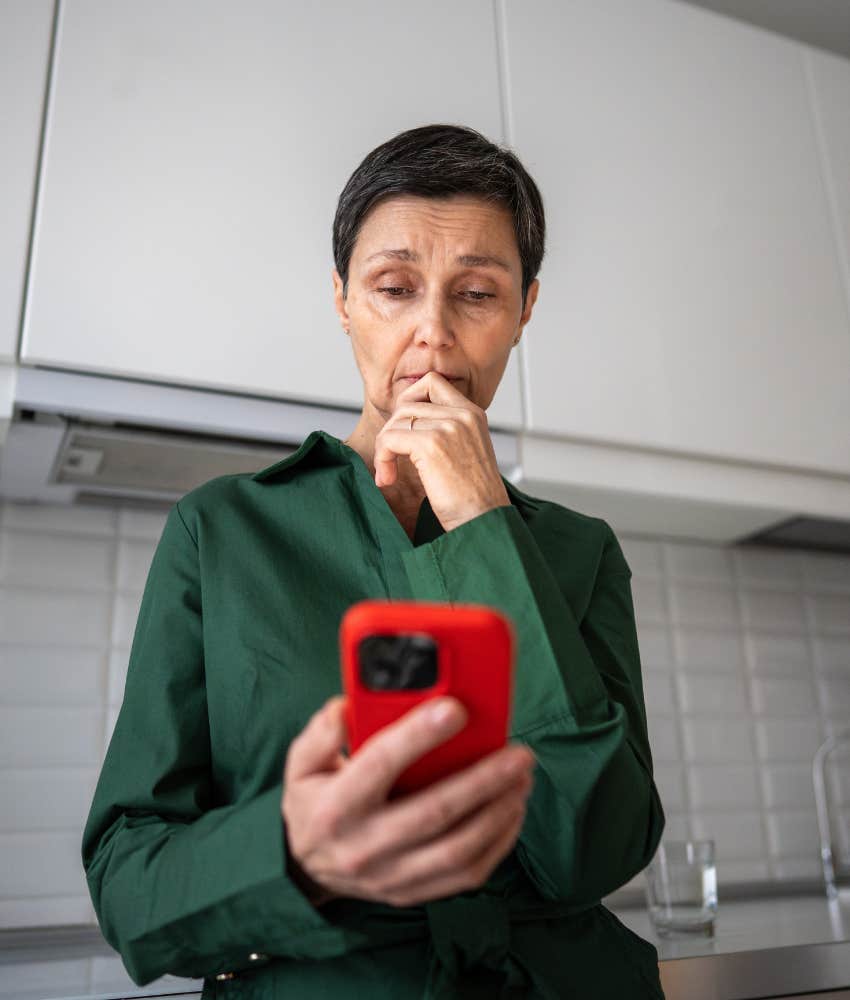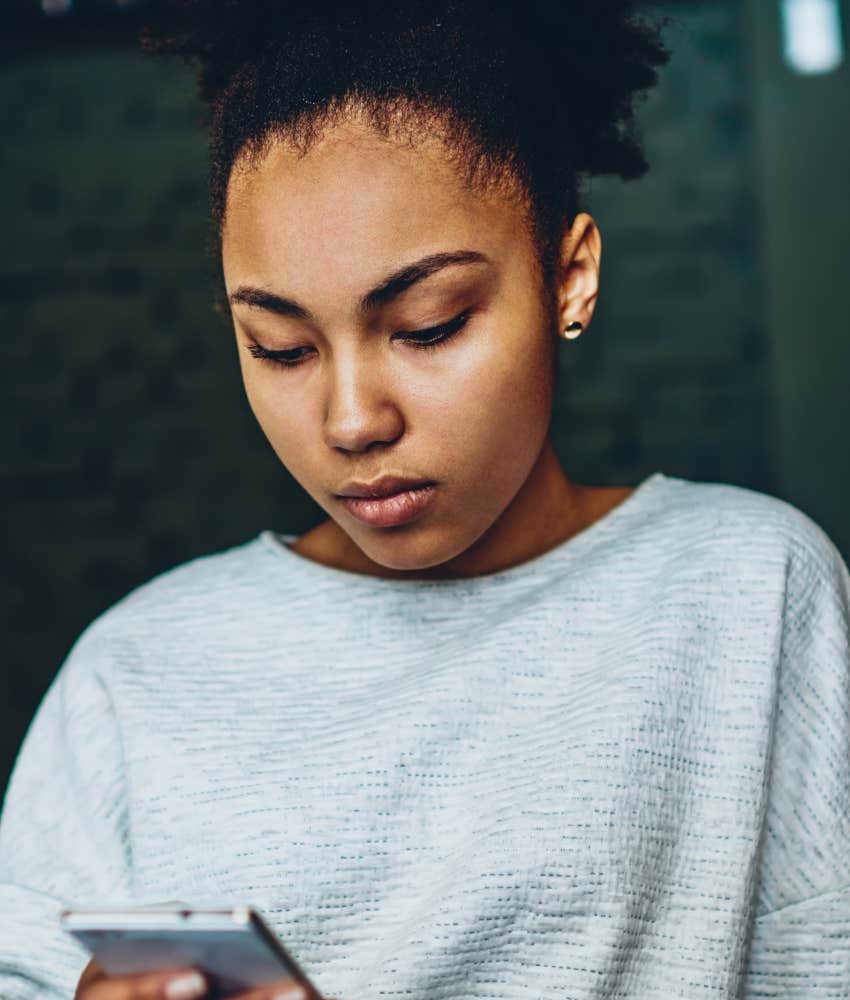The Art Of Unplugging: 13 Clever Tricks To Make Your Social Media Detox Stick
Taking a break from scrolling sounds easy, until you actually try it.
 Peopleimages.com - YuriArcurs | Canva
Peopleimages.com - YuriArcurs | Canva Are you feeling personally attacked by your weekly screen time report? Do you feel naked when you accidentally leave the house without your phone? Have you scrolled past the same photos on your Instagram feed 20 times today? It could be time for you to take a social media detox.
Research on the link between social media use, anxiety, and depression showed that people who limit themselves to 30 minutes of social media use a day have significantly lower depressive and anxiety symptoms compared to a control group. The results suggest this time frame is a beneficial routine to emulate on a long-term basis.
Whether you’re trying to ditch social media for good, take a week-long detox, or just looking to reform your social media habits, these expert tips will help you rediscover a more digitally disconnected lifestyle.
Here are 13 clever tricks to make your social media detox stick:
1. Observe your habits
“It's a popular addiction right now, one of the still socially acceptable ones," Laurie Gerber, an expert life coach of the Handel Group, explained: "We've only been in the Information Age for how many years? Our brains are not adjusted to the amount of interesting input that's possible to take in. You could spend all day on social media and not really get bored. And the smarter the programs get at giving you what they think you want, the harder it will ever be to stop."
To ditch a bad habit, you have to recognize that habit first. Identify what is causing you to reach for social media and what apps you resort to. Is it for entertainment? For social interaction? Out of fear of missing out?
Gerber suggests continuing to observe your habits while on your detox, explaining, "Experiment with nothing just to see what it brings up, to feel the addiction, to see what the triggers are, to see what you replace it with. Everybody can go a certain amount of time with none."
2. Delete your social media apps
 DimaBerlin via Shutterstock
DimaBerlin via Shutterstock
This may be an obvious step, but it’s certainly not one to overlook. Often, selecting social media apps is like a reflex we don’t even realize we’re doing until we’re 10 scrolls deep on a Twitter thread. Removing the apps from your home screen omits this reflex entirely.
Think of it as retraining your brain to find other ways to occupy itself. You can always re-download the apps once your detox is over.
3. Deactivate your accounts
It may also be helpful to temporarily deactivate your socials. Instagram, Twitter, and Facebook all allow users to disable their accounts without deleting them entirely.
Your profile won’t be visible to search or contact, but all of your posts and photos will still be saved for when you do reactivate your accounts. This will completely remove the FOMO surrounding notifications or tags. You won’t feel like you're missing out because there will be nothing to miss out on.
Author Trine Syvertsen spoke of social media’s addictive qualities, saying, “They’re set up to make you wait for something to change or for something to happen. People tell me that they know that they’re wasting their time, but it feels really hard to get out. Deactivating your account restores your autonomy by breaking this cycle."
4. Turn off notifications
While most experts would suggest being hard on yourself, sometimes deleting your apps or accounts can be intimidating or just not an option for you. Instead, try silencing your notifications from social media apps, particularly the ones that distract you the most.
What starts as one quick message can drag you into a 2-hour Instagram browse, so it can help to limit the reasons to pick up your phone in the first place. This can be particularly helpful in keeping you focused on work.
5. Block all social media sites
Keeping yourself off social media on your phone is just one step. Carrying your detox into your laptop or tablet is a whole different ball game. The temptation to keep a tab open for Twitter or Facebook is always there, especially if you’ve deleted the apps from your phone. A web filtering tool will keep these sites out of your recent search history and keep you focused. The idea here is that you put as many obstacles as possible between you and your socials.
Lindsay Tulchin, Ph.D., a clinical psychologist, recommends, "Most people end up mindlessly scrolling because the act of clicking the app is a learned habitual behavior, meaning it's not always totally conscious! If you set up your environment to make scrolling a conscious decision, you set yourself up to be more successful in detoxing."
6. Set aside a detox day
 PeopleImages.com - Yuri A via Shutterstock
PeopleImages.com - Yuri A via Shutterstock
For those whose work revolves around social media, or those who need to keep their apps open all day for practical purposes, you aren't exempt from this detox! Just one day a week can alleviate some of the digital doom we feel from our social media usage.
I try to take Saturdays off since this is typically the day I use to let go of the week, hang out with family and friends, and just generally organize my life. Putting my phone away allows me to be truly present in whatever I’m doing. And by the time Sunday rolls around, I feel more refreshed and ready to return to social media.
7. Reorganize your home screen
Again, creating hurdles can keep you away from mindlessly opening social media apps. Shuffling around your home screen every couple of days means you really have to think about what you’re doing on your phone. This gives you more time to self-reflect and ask yourself whether you really need to be browsing social media right now.
8. Set time limits for using apps
If you’re attempting the 30 minutes per day rule, app limits can be really helpful. Look for your phone's app limit feature, which allows you to choose how long you want to spend on particular apps before it will lock you out. This will train you to prioritize which apps you really need access to and which apps are taking up your time for no reason.
9. Put your phone away
Life can be mentally tiring enough without having to retrain your entire psyche to avoid your phone. Creating physical distance between you and your social media can be more effective in avoiding mindless screen use. It allows you to focus on what you’re doing or who you’re with, rather than always keeping one eye open for a notification bell or lit-up screen. This can be particularly beneficial before you go to bed so you have time to unwind and relax, and can have better quality sleep.
Syvertsen says, “The impression I get is that space restrictions are most effective. It’s easier to do than time restrictions. So if you put away your phone physically, or you move to a room where you don’t have physical screens, or you agree with the people around you that all meals, for example, will be screen-free, that seems to be easier for people than, for example, setting personal time limits.”
10. Get a real alarm clock
I know what you’re thinking: no phone means no alarm. If only someone had invented something to help us wake up before phones became our only source of alarm. Oh, wait.
Using a real alarm clock means you’re not reaching for your phone first thing in the morning. You can wake up and be present in the moment instead of immediately getting caught up in emails, texts, and notifications that clog your lock screen while you sleep. Instead of scrolling on your phone before your eyes have adjusted to daylight, use this time to set your intentions for the day and find focus before you get out of bed.
11. Set rewards and consequences
Just like when you’re training a puppy or disciplining a child, having consequences and rewards for actions is essential to sticking with a routine. Use social media as an enjoyable form of entertainment after working hard all day, or tell yourself that if you fail to stay off social apps, you can’t have dessert.
If you view your time on social media as something you’ve earned, you’ll be able to really appreciate being able to reply to messages and interact with posts instead of just doing so mindlessly.
12. Unfollow people
 GaudiLab via Shutterstock
GaudiLab via Shutterstock
Having countless accounts, pages, and groups to follow and keep up with makes social media a go-to entertainment source that’s constantly being updated. When limiting your social media usage, it helps to cut down on who and what you’re keeping up with.
With less to see and do, you’ll learn to put your phone down once you’ve caught up on all you need to see. This also helps to cut out any accounts or sources that provide content to make you feel bad about yourself or that don't benefit your life in any meaningful way.
13. Replace your screen time with other activities
Social media is the ultimate distraction, so try fighting fire with fire by having other distractions that will keep you off your devices. We’ve already discussed how hanging out with people in real life can hedge any mental health problems that overuse of social media might be causing.
It’s also important to have hobbies and relaxing activities to keep your mind off your phone. Try going for walks, reading a book, or pampering yourself with a face mask instead of reaching for your phone when bored.
It’s no secret that our collective screen time has skyrocketed. But this endless feed of entertainment isn’t all good news. Social media can leave us feeling pretty down sometimes. Having millions of people to compare ourselves to at the click of a button and millions more upsetting news stories to access just as quickly can have detrimental effects on our mental health.
One large-scale study from 2017 found that infrequent users of social media are far less likely to be depressed than heavy users. But even passive users aren’t immune to the effects of social media. Research on the effects of envy and social media indicates that even those who just digitally check in with their social circle are prone to developing negative feelings of resentment and anxiety. The internet’s favorite slang word, FOMO (fear of missing out), is more than just a passing joke. It’s becoming a harmful mental state. So, how do we resist the downsides of the digital age? By taking a social media detox.
What is a social media detox?
A social media detox or digital detox is a conscious “switching off” that gives people a break from their screens.
"'Digital detox' is predominantly used as an umbrella term for quitting digital platforms or devices for a period of time. In practice, digital detox means very different things to different people," says Dr. Rachael Kent, a teaching fellow in Digital Media and Culture at King's College London.
If you’re working from home, it’s impossible to completely step away from all screens, but you may be able to quit social media for a day or two. If you use social media to stay in touch with loved ones, quitting “cold turkey” may not be an option for you; still, consider cutting down the amount of time you spend on certain apps.
The purpose of a social media detox is not to regress to the age before technology, and resort to using letters and carrier pigeons to contact our friends. It’s simply designed to give your mind a break from the constant doom-scrolling and allow you to reconnect with yourself, away from your phone.
Why is detoxing from social media good for you?
Like most things in life, social media should be consumed in moderation. The logic behind social media is not that all things digital are bad and are destroying our society; however, the overconsumption and over-reliance on social media for entertainment and socialization are disrupting our abilities to focus and be present.
One study on social media use before bed shows it is associated with poorer sleep habits, leading to increased anxiety and depression. Another study indicates that young people who use social media for over 2 hours per day are more likely to rate their mental health as "fair" or "poor" compared with occasional users.
And while we may justify our use of social media by declaring it our primary way of interacting with others, this is little more than a perception. In reality, social media isn’t all that social. Research indicates that real-life socializing is more beneficial to your mental health than social media.
How long should your social media detox last?
There is no one-size-fits-all social media detox. Like any diet or exercise plan, the length or intensity of your social media detox depends on what you want out of it.
To start, it’s important to interrogate your own social media use. How much time are you spending on social media? How much of this time is actually necessary?
Often, finding a social media detox that works for you is about assessing how you feel when you quit and observing how you operate without these apps.
"The problem is, people don't really understand the consequences of their choices," Gerber weighs in. "People really don't understand how good they'd feel if they didn’t drink the night before or stay up late on social media — until they try cold turkey. So I would give everybody the job of, at least, going cold turkey for one week."
But a cold turkey detox isn’t feasible for everyone, nor is it practical on a long-term basis. While this is a great way to start your new digitally cleansed life, finding a sustainable balance is key to getting the most out of a detox.
How many times have you tried to go on a no-carb diet only to end up gorging on bread, pastries, and pizza after one week? Wouldn’t it have been more beneficial to just reduce the carbs instead of cutting them out entirely? The same goes for life after your social media hiatus.
Alice Kelly is a writer with a passion for lifestyle, entertainment, and trending topics.

